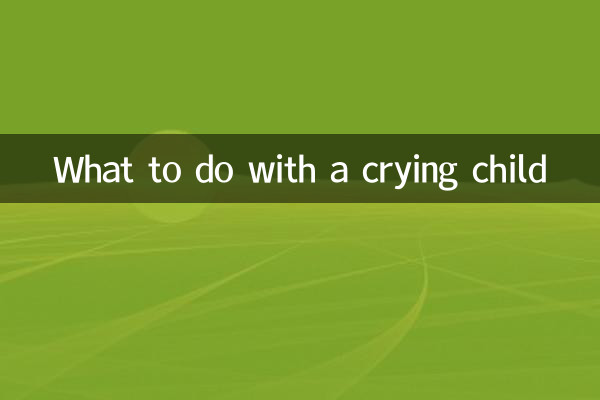What to do with a crying child: hot topics and solutions on the Internet in the past 10 days
Recently, discussions about managing children’s emotions have become a hot topic on social media and parenting forums. Many parents report that their children’s frequent crying is troubling. This article combines hot topics and data from the entire Internet in the past 10 days to provide you with structured analysis and practical suggestions.
1. Ranking of popular parenting topics in the past 10 days

| Ranking | topic | amount of discussion | heat index |
|---|---|---|---|
| 1 | Emotional management of crying children | 58,742 | 9.8 |
| 2 | How to distinguish normal crying from problem behavior | 32,156 | 8.5 |
| 3 | The psychological needs behind crying | 28,943 | 8.2 |
| 4 | Common misunderstandings parents make when dealing with crying | 25,671 | 7.9 |
| 5 | Practical tips for emotional guidance | 22,358 | 7.6 |
2. Analysis of common causes of children crying
According to discussions and case analysis by parenting experts in the past 10 days, children’s frequent crying is mainly due to the following reasons:
| Reason type | Proportion | Typical performance |
|---|---|---|
| Physiological needs | 35% | Hunger, sleepiness, discomfort, etc. |
| emotional needs | 28% | Attention seeking, lack of security |
| communication barriers | 20% | Unable to express needs or emotions |
| environmental pressure | 12% | Overstimulation, change, etc. |
| other | 5% | Illness, special needs, etc. |
3. Coping strategies recommended by experts
1.Recognize crying signals: Establish a "crying diary" to record the time, situation and duration to help identify patterns.
2.emotional acceptance: Use language such as "I see you are sad" to help children identify their emotions instead of simply stopping them.
3.alternative expression training: Teach children to use simple words or gestures to express their needs and reduce the frequency of crying.
4.Create a sense of security: Establish a sense of security through regular work and rest and stable companionship, and reduce anxious crying.
5.Positive Facilitation Techniques: Give positive feedback when the child is calm to reinforce positive behavior.
4. Common misunderstandings of parents and suggestions for correction
| Misunderstanding | Influence | Suggestions for correction |
|---|---|---|
| excessive soothing | Reinforce crying behavior | Delay responses and wait until the child calms down before communicating |
| Strictly stop | cause emotional depression | Allow moderate venting and guide expression |
| ignore root cause | Problem persists | Observe the system and solve potential problems |
| emotional reaction | increase tension | Stay calm and demonstrate emotion management |
5. Differences in coping strategies among different age groups
According to the advice of child development experts, the way to deal with crying needs to be adjusted with age:
| age group | Main features | Key points to deal with |
|---|---|---|
| 0-1 years old | Physiological needs mainly | Meet basic needs in a timely manner |
| 1-3 years old | budding sense of autonomy | Provide limited choices and guide expression |
| 3-6 years old | Increased social needs | Teaches social skills, emotional vocabulary |
| 6 years and above | rational ability development | Analyze and solve problems together |
6. Recommendation of practical tools and resources
1.Emotional awareness cards: Help children identify and express different emotions.
2.soothing toys: Provides a sense of transition and relieves separation anxiety.
3.mood thermometer: Visualization tool helps older children quantify emotional intensity.
4.Picture books for parents and children to read together: "My Little Emotional Monster", "Angry Soup" and other classic emotion management picture books.
5.Parent support community: Join formal parenting communities, share experiences and gain support.
By systematically understanding the reasons why children cry and scientific solutions, parents can handle this common challenge more calmly. Remember, crying is a necessary stage for children to grow up. Proper guidance can not only solve the current problem, but also help children build emotional management skills that will benefit them throughout their lives.

check the details

check the details